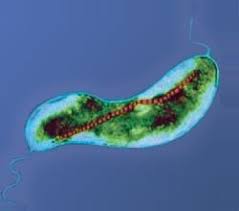Magnetotactic Bacteria:

Researchers have uncovered fossil remains of magnetic particles, known as magnetofossils produced by magnetotactic bacteria, in rock varnish layers in Ladakh, India.
- Magnetotactic bacteria are mostly prokaryotic organisms that arrange themselves along the earth’s magnetic field.
- These are present in freshwater and marine habitats.
- These organisms were believed to follow the magnetic field to reach places that had optimal oxygen concentration.
- These bacteria contained “novel structured particles, rich in iron” in small sacs that essentially worked as a compass.
- These magnetotactic bacteria create tiny crystals made of the iron-rich minerals magnetite or greigite. The crystals help them navigate the changing oxygen levels in the water body they reside in.
- It is believed that these microbes may represent some of Earth’s earliest inhabitants.
Highlights of the research:
- Researchers are inspired by the similarities between the rock varnish in Ladakh and those observed on Mars by the Perseverance rover.
- They identified elevated concentrations of oxidized manganese (Mn4+) and carboxylic acid functionalities on the varnish surface, suggesting the presence of organic signatures.
- These findings indicate that the magnetic minerals in the rock varnish are likely biotic in origin.
- By detecting biotic signatures in rock varnish, scientists can better focus on identifying biosignatures on Mars and other celestial bodies.
- This information is crucial for future space missions, including those planned by ISRO and other space agencies, aiming to explore Mars and assess its habitability




